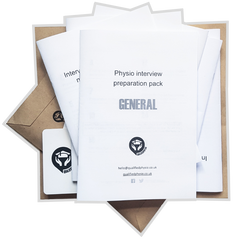.
Updated 3rd Jan 2021
Are you confident your personal statement will get you shortlisted for the job you want? Take a look at these 8 steps to write the perfect application and make sure you get through to the interview.
NB: Although this is applicable to most job adverts out there, bear in mind that this article focuses on the process of applying for a job through the NHS Jobs website.
All articles from the Physio Interview Preparation blog series ››
1. Mirror the job description and person specification
Read the job description and person spec, and read them again. These are what your application will be marked against. You’ll have to make sure you provide enough evidence for each of the criteria. To make it as easy as possible for the reader, the easiest thing to do is to mirror the language used in the job description and person spec. Obviously mirror doesn't equal copy-paste, but if the job description says you need to be able to work in a range of community, inpatient and outpatient locations across a certain borough, then tell them you're able to do that. If the person spec says you need to manage a caseload and prioritise under pressure, then write about how you can do that too. Your employer needs to know that you’re meeting all the criteria, and the clearer it is for them, the better.
A good thing to do is to start writing your application using the same subheadings as the person specs (eg: qualifications, skills, experience, knowledge) and then remove them if you like (nothing prevents you from leaving them in for added clarity). For now - don’t worry about the word count if there’s one, just make sure you’ve got everything in.
2. Give examples from your own experience
You should now have the "skeleton" of your supporting statement. It is crucial to add specific examples from your own experience to substantiate what you’ve been writing about. This will basically show the employer that you’re not just talking hot air. For each of the points you've talked about, think of an example taken from work/academic experience, placements, but also voluntary work, previous jobs, hobbies etc. (think transferable skills) and describe what happened and how you’ve demonstrated your ability to perform that specific skill. Try describing what you did, but also why you did it and what the outcome was. You’ll find that some of the examples or situations you’ll describe will often cover more than one criteria from the person spec. For instance, you can talk about how you've managed your own caseload during a placement on an elderly care ward, delegating to TAs when appropriate. If you expand correctly on this, you’ll cover several criteria such as experience with inpatients, delegation, prioritisation, caseload management, working under pressure. This will help you keep your application short and sweet (and staying within the word count if there’s one).
3. Give the employer extra reasons to employ you
Now that you’ve covered all the required skills and criteria, think about extra reasons why the recruiter should choose you over someone else. Really sell yourself. Any other skills you have that could give the employer more reasons to employ you?
If you are graduating in 2021 and feel you may be missing some “core” practical skills, try and think about transferable skills that you may be able to draw from less traditional ways. Thinking especially about those of you who have done less traditional placements in areas like project leading, QI, etc.
Think about the values of the hospital or clinic you're applying for. Do your homework on the employer and show how you’ll be the best new addition to their team. You will definitely get your interviewer's attention if you are able to write about specific research projects or specific developments the Trust is focusing on now or in their laid out 5 year plan (think services affected by COVID19, or meeting new service users' needs such as long term covid etc).
As a general rule, it’s best to show how well you will fit in the team/how great you'll be at the job you're applying for, as opposed to focusing on the feedback you've had previously. One of the reasons for this is that employers cannot necessarily rely on what people have said in the past to make their decision, but need to quickly identify whether you will be the right fit for their team. If you help them do that, you'll have more chances to be selected.
4. Watch out for extra questions
More often than not, the employer will ask for extra stuff such as answering a couple of questions as well as completing your application. Make sure you read the job advert a few times as well as the person spec and job description (and any other documents provided) so you don’t miss these. Make it clear in your supportive statement if you're answering additional questions (use subheadings).
Example of extra questions include: “Describe how you would ensure your personal safety when working alone in the community?”, “Describe how you would utilise your physiotherapy skills in the management of dementia?” You usually have a word limit for these.
5. Proofread, proofread, proofread.
Spelling and Grammar! Make sure you proofread, and show your application to other people so they do the same too. First impressions really count, and if your letter contains typos and mistakes, it’ll just look unprofessional. Use strong words - ban words like hope, if, think. Ensure your letter demonstrate your ability to meet each criteria but keep it as short as possible. Avoid long sentences and make sure your paragraphs are easy to follow. It has to be easy to read - if the recruiter gets an headache reading you, you won’t last long.
Don't forget you can send us your CV & application for review!
6. Don't get done on the easy stuff
Now the easy part. Make sure you fill everything in, tick all the boxes you need to tick, provide your full contact details and proofs of professional registration (HCPC, CSP). Referees may be contacted prior to interview: ask your referees if they are happy with that before putting their names down. Then make sure you provide up-to-date contact details for them to avoid any delays (email addresses especially, it's easier for everyone). If you're not sure about something, don't hesitate to contact the employer. Their details will usually be on the advert. This will also give you a chance to clarify a few things about the interview and know who's likely to be on the panel. Lastly, watch out for the deadline given: applications often close before the said date due to the maximum number of applicants allowed being reached.
7. Get ready for the interview
Make sure your CPD portfolio is up-to-date and easy to flick through. Also, be comfortable talking about what you've written in your application: you're likely to be asked about it! If you know who the interview panel is going to be, do your homework and know their specialities: this often influences their questioning. Lastly: revise!
8. Ask for feedback
If you're unsuccessful, contact the employer and ask if they can provide any feedback about your application. Use this to tweak your application and make sure you'll get shortlisted next time.
Related products




![[2022] Band 5 / Junior MSK Physiotherapy interview question & its answer explained](http://qualifiedphysio.co.uk/cdn/shop/articles/pexels-andrea-piacquadio-3756042_compact.jpg?v=1641201968)